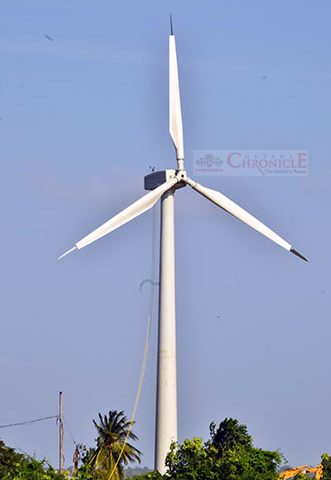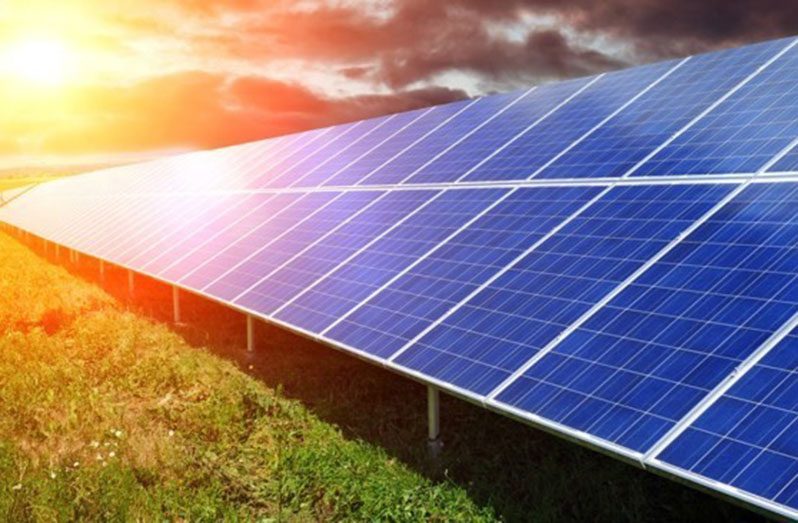AS part of its mission to implement a comprehensive energy mix, the Government of Guyana has already secured US$75 million in funding to establish solar farms in eight grids. This, according to the updated and expanded Low Carbon Development Strategy (LCDS), is being done with the intention of producing some 27.8 megawatts-peak (MWp) of solar power to the Demerara-Berbice Interconnected System (DBIS).
The farms are expected to be up and running by 2023, paving the way for solar-generated power to replace 30 per cent of the electricity being supplied to areas along the Essequibo coast, Linden, Bartica, Lethem, Mabaruma, Mahdia, Leguan and Wakenaam.
“Solar Photovoltaic (PV)– DBIS and Isolated Grids Solar photovoltaic (PV) is close to being established as a mature technology in the country. Local prices are in-line with developed countries and local technology providers have the capacity to supply, install and operate on-grid and off-grid,” LCDS 2030 noted.
It outlined too that within the next two years, the Guyana Power and Light (GPL) will have its first solar on-grid PV farm in Berbice, boasting of a total capacity of 10 megawatts-peak, and generating at least one per cent of the total energy demand in DBIS.
In addition to the government-funded solar projects, LCDS 2030 also encouraged “self-generation,” which it says is allowed as per Guyana’s legislation. “Any consumer who wishes to interconnect their solar PV system into the public grids to eliminate the need for battery storage (solar PV on-grid) must submit an interconnection request and comply with the Interim Interconnection Requirements set by GPL,” the document noted.
Meanwhile, it specified that as part of the “roof-top solar PV for government buildings programme, about five megawatts was [sic] installed at 291 buildings across the 10 administrative regions during the period 2012-2020”.
In a second phase of the programme for the hinterland grids, there is a planned increase of the renewable energy share to an average of 50 per cent. Via this particular project, an estimated 30,000 households in several hinterland communities across the country are set to benefit from a solar lighting programme which is being funded by a US$7.2 million line of credit from the Government of India via the India Exim Bank. The installation of these 150-watt systems are expected to be completed in 2022.
ICT
Additionally, efforts are afoot to install Information and Communications Technology (ICT) hubs in all of Guyana’s 200 hinterland villages. Slated to be completed between 2021 and 2022, the project includes the installation of an average of four-kWp solar PV system to power each ICT hub. This is being done under a project called “ICT Access and E-Services For Hinterland, Poor and Remote Communities,” which is being funded by the Guyana REDD+ Investment Fund (GRIF).

Further, as part of the 2021 national budget, the People’s Progressive Party/Civic has approved the installation of 10 more solar PV mini-grid systems in villages such as Sebai, Waramadong, Paruima, Kurukabaru, Whyaka, Mission Capoey, Lake Top Capoey, Annai, St. Monica and Karaburi, totalling 1.472 MWp (an average of 147kWp/village). Those systems, according to the LCDS, are expected to be in operation by 2022.
Also in 2021, Guyana signed a grant agreement with the International Solar Alliance for the establishment of a solar demonstration project in Orealla, Region Six (East Berbice-Corentyne), which will see the installation of a 9kWp grid-tie solar photovoltaic system, accompanied by a battery energy storage system of 37kWh.
“Solar PV with battery storage will be the main renewable energy resource on the regional grids,” the updated LCDS noted.
PLEDGE
Only recently, President Dr. Irfaan Ali pledged Guyana’s intention to have 70 per cent renewable energy by 2030, owing to the implementation of a comprehensive energy mix using solar, wind, hydro and natural gas.
The Guyanese Head of State had even expressed confidence that once the projects put forth by his government are realised, Guyana would be able to reduce the overall cost of energy by 50 per cent.
Moreover, Dr. Ali believes that these projects could also position the country as an emerging energy capital of the Region, and perhaps even a net energy exporter. A net exporter is a country or territory whose value of exported goods is higher than its value of imported goods over a given period of time.
Dr. Ali had previously announced that already, Guyana has commenced discussions with its territorial neighbours Brazil and Suriname, for the establishment of an “energy corridor.” International experts have said that energy corridors may accommodate multiple pipelines for oil, gas, or hydrogen, electricity transmission lines, and related infrastructure, such as access and maintenance roads, compressors, pumping stations and other structures.
Even as it looks to build a thriving oil and gas industry, the government has repeatedly said that it will continue to pursue Guyana’s development in a manner that supports the global fight against climate change.




.png)









